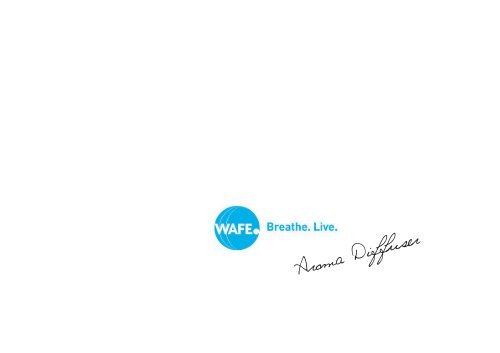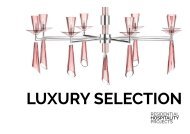Prezentace_aromalampa_STUDIE__update_72dpi
Create successful ePaper yourself
Turn your PDF publications into a flip-book with our unique Google optimized e-Paper software.
Aroma Diffuser
• zdravé dýchání<br />
• zdravý způsob života<br />
• harmonie<br />
• čistota<br />
• žena<br />
• rodina, děti<br />
• atmosféra lesa (vlhko, ticho)<br />
• vzduch v lese<br />
• vizuálně hezké<br />
• bezpečné (děti)<br />
• stabilní<br />
• nerozbitné<br />
• na elektrickou energii<br />
• z plastu?
Aroma lampa, nebo aroma “difusér”(Essential Oil Diffuser, Aroma Diffusers)?<br />
Typy:<br />
• “Nebulizing Diffusers” - rozprašovací, bez tepla<br />
• “Ultrasonic Diffusers” - elektonické frekvence/vibrace, bez tepla, s vodou<br />
• “Evaporative Diffusers” - odpařovací, “větrák” nebo přirozenou cestou (bez tepla)<br />
• “Heat Diffusers” - teplo
Nebulizing Diffusers<br />
A nebulizer works basically the same way a perfume<br />
atomizer works. A jet of air blowing across a small<br />
tube creates a vacuum that pulls a liquid at the<br />
bottom of the tube to the top of the tube. The air flow<br />
blowing across the surface of the oil at the top of the<br />
tube blows the oil away in a fine spray or mist. With<br />
a constant air supply source, this type of diffusion<br />
can quickly put a large amount of oil into the air.<br />
Nebulizing diffusers are often considered the most<br />
powerful type of diffusers and with good reason. They<br />
do not need water or heat to get the essential oil in to<br />
the air and they work by using an atomizer to create<br />
fine, airborne particles of essential oils and blowing<br />
them in to the air. Nebulizing diffusers keep a nearcontinuous<br />
stream of essential oils in the air.<br />
Positives:<br />
• The nebulizing diffuser we have attaches directly to<br />
the bottle of essential oil and can be turned on with<br />
the flip of a switch.<br />
• No water or set-up required.<br />
• Strong concentration of essential oils released in to<br />
the air.<br />
• Timers for run time and rest time let you control how<br />
long it runs and makes it ideal for overnight use (if<br />
needed).<br />
• No light so they can be used at night.<br />
Negatives:<br />
• Louder than ultrasonic diffusers.<br />
Uses oils more quickly than ultrasonic or other<br />
diffusers since they attach directly to the diffuser.<br />
• More expensive than most ultrasonic diffusers<br />
(though not by much)
Ultrasonic Diffusers<br />
Ultrasonic diffusers work in a similar way to nebulizing<br />
diffusers by creating a fine mist. The difference is<br />
that ultrasonic diffusers use water and essential oils<br />
to create a cool mist of water/oils that releases in<br />
to the air. They double as a humidifier, so they are<br />
beneficial in winter, but they don’t put out as strong<br />
of a concentration of essential oils since they also<br />
use water. This diffuser uses electronic frequencies<br />
to create vibrations in water, that are carried to the<br />
surface where the essential oils are floating. The<br />
vibrations vaporize the essential oils and disperse<br />
them into the air without using any kind of heat at all.<br />
(An ultrasonic diffuser utilizes electronic frequencies<br />
to cause a small disk under the surface of a liquid<br />
-usually water- to vibrate at a very fast rate. These<br />
ultrasonic vibrations break the essential oil into tiny<br />
microparticles, dispersing the oil in a fine mist. These<br />
tiny particles are more easily absorbed by the lungs<br />
for a greater therapeutic effect on the body, mind, and<br />
spirit.) Unlike heat diffusers, these do not destroy the<br />
therapeutic properties of the essential oils being used.<br />
These diffusers do a great job of purifying the air and<br />
removing unwanted odors! It is not recommended<br />
to use citrus essential oils with this type of diffuser<br />
as they can cause the parts to erode. It is not<br />
recommended to use citrus essential oils with this<br />
type of diffuser as they can cause the parts to erode.<br />
Positives:<br />
• Less expensive than nebulizing diffusers.<br />
• Doubles as a humidifier (beneficial in cold months).<br />
• Many options to choose from.<br />
Negatives:<br />
• Can’t use citrus essential oils.<br />
• Need water to operate.<br />
• Must be cleaned occasionally.<br />
• Some have lights that can’t be turned off.<br />
• Not as effective as nebulizing diffusers.
Evaporative Diffuser<br />
Evaporative diffusers are very basic in operation<br />
compared to ultrasonic diffusers. A fan blows air<br />
through a pad or filter where the oil sits and vaporizes<br />
the oil on the pad. This type of diffuser also includes<br />
the clay pendants, inhalers, and glass pendants. The<br />
biggest problem with evaporative diffusers is that<br />
the lighter oils (top notes such as citrus) diffuse off<br />
quicker than the heavier oils (base notes). Compared<br />
to the other diffusers, these aren’t as great for<br />
therapeutic use in large rooms, but are great for<br />
personal use in your vehicle or when traveling!<br />
While this method of diffusion works well at getting<br />
the scent of the oil into the room, there is one<br />
drawback to this method: anytime an essential oil<br />
evaporates, some of the lighter, or more volatile,<br />
components of the oil tend to evaporate much faster<br />
than the heavier and less volatile components. This<br />
means that instead of getting the whole oil all at once,<br />
you are getting a higher percentage of the lighter<br />
components at the beginning of the process and a<br />
higher percentage of the heavier components towards<br />
the end of the process.
Heat Diffuser<br />
Like evaporative diffusers, heat diffusers also cause<br />
the essential oils to evaporate quicker than normal<br />
but use heat instead of blowing air to accomplish<br />
diffusion.<br />
While some heat diffusers use high levels of heat to<br />
produce stronger smells, the best heat diffusers will<br />
only use very low levels of heat that produce more<br />
subtle aromas. This difference is important because<br />
high levels of heat can actually alter the chemical<br />
constituents of the oils.<br />
Although heat diffusers do share the same drawback<br />
of any diffuser that relies on evaporation—the potential<br />
of fractionating the oil into its components instead of<br />
putting the whole oil into the air––heat diffusers are<br />
a very economical and totally silent method of putting<br />
an oil’s aroma into the air.<br />
(Great for spreading a lovely scent throughout your<br />
home, heat diffusion is best for pretty smells only.<br />
If you are wanting the therapeutic properties of<br />
essential oils then heat should be avoided. Heat alters<br />
the chemistry of the oil, removing any therapeutic<br />
properties it might have had. These type of diffusers<br />
are great simply to make a room or your home smell<br />
better!)
$27.59
Design:<br />
• materiál??? (plast, sklo, kov, keramika, kámen, porcelán, dřevo,...)<br />
• odolnost vůči teplotě (žáruvzdorný, nehořlavý plast???)<br />
• plocha, jakou má difusér provonět<br />
• časový spínač<br />
• baterie/síťové připojení<br />
• ovládání teploty<br />
• funkce osvětlení (přímé ambientní)<br />
• USB (nabíjení, ovladatelné přes aplikaci, bluetooth)<br />
• kvalita vůně/oleje<br />
• obsluha (voda/teplo)<br />
• údržba<br />
• dálkové ovládání<br />
• přenosnost<br />
• bezpečnost<br />
• stabilita<br />
• vzhled<br />
• výrobní náklady
Voda. Prameny vody.
d = 14cm, v = 10cm
Rostliny. Kviti.
d = 12cm, v = 7cm
Les. Stromy.
d = 10 cm, v = 12 xm
a = 10 cm, b = 10cm, c = 12 xm
c<br />
Mag. des. ind. Bc.<br />
Klára Procházková<br />
+420 774 892 889<br />
pro.klara@gmail.com







